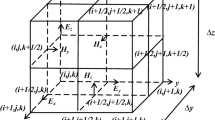Abstract
One of the most critical hardware components of a ground-penetrating radar (GPR) is the antenna system. Important parameters of antennas, such as antenna bandwidth, radiation waveform and cross coupling determine the GPR system performance. The modified TEM horn antenna with distributed resistor load is presented in this paper, and the radiation properties of the antenna with the shields and absorbers are studied through the three-dimensional finite-difference time-domain (FDTD) scheme. Simulations show that the direct signal coupled from the transmitter is decreased by means of the shields and absorbers. Therefore, using the antenna in the GPR system can improve the signal-to-clutter ratio and the dynamic range of the system.
Similar content being viewed by others
References
Daniels D J, Gunton D J, Scott H F. Introduction to subsurface radar. In: Proceedings of IEE, 1988, 135(4): 278–320
Ge D B, Yan Y B. The finite difference time domain method for electromagnetic wave. **’an: **dian University Press, 2002 (in Chinese)
Kunz K S, Luebbers R J. The finite difference time domain method for electromagnetic. Boca Raton: CRC Press, 1993
Bourgeois J M, Smith G S. A fully three-dimensional simulation of a ground-penetrating radar: FDTD theory compared with experiment. IEEE Transactions on Geoscience and Remote Sensing, 1996, 34(1): 36–44
Zhan Y, Liang C H, Fang G Y, et al. Simulation of bow-tie antennas above ground and its applications, Chinese Journal of Radio Science, 2000, 15(2): 134–138 (in Chinese)
Yan X R, ** Y S, Luo C M. Analysis of wide-band properties and efficiency for dipole antennas with resistive and capacitive loadings. Chinese Journal of Radio Science, 2000, 15(2): 169–173 (in Chinese)
Zhou W H, He J G, Zhou D M. Optimized design of a new kind of GPR planar antenna. Chinese Journal of Radio Science, 2004, 19(3): 371–373 (in Chinese)
Lestari A A, Yarovoy A G, Ligthart L P. Improvement of bowtie antennas for pulse radiation. IEEE Antennas and Propagation Society International Symposium, 2002, 4: 566–569
Lee K-H, Venkatarayalu N V, Chen C-C. Numerical modeling development for characterizing complex GPR problems. SPIE, 2002, 4758: 652–656
Lacko P R, Franck C C, Johnson M, et al. Archimedean-spiral and log-spiral antenna comparison. SPIE, 2002, 4742: 230–236
Liu L Y, Su Y, Liu K K, et al. Radiation characteristics of GPR antenna through FDTD method, Journal of Microwave, 2005, 21: 91–95 (in Chinese)
Maloney J G, Shlager K L, Smith G S. A simple FDTD model for transient excitation of antennas by transmission lines. IEEE Transactions on Antennas and Propagation, 1994, 42(2): 289–292
Gürel Levent, Oǧuz U. Simulations of ground-penetrating radars over lossy and heterogeneous grounds. IEEE Transactions on Geoscience and Remote Sensing, 2001, 39(6): 1190–1197
Berenger J P. A perfectly matched layer for the absorption of electromagnetic waves. Journal of Computational Physics, 1994, 114(2): 185–200
Fang J Y, Wu Z H. Generalized perfectly matched layer for the absorption of propagating and evanescent waves in lossless and lossy media. IEEE Transactions on Microwave Theory Techniques, 1996, 44(12): 2216–2222
Author information
Authors and Affiliations
Corresponding author
Additional information
__________
Translated from Chinese Journal of Radio Science, 2006, 21(3): 422–427 [译自: 电波科学学报]
About this article
Cite this article
Liu, L., Su, Y. & Mao, J. FDTD analysis of ground-penetrating radar antennas with shields and absorbers. Front. Electr. Electron. Eng. China 3, 90–95 (2008). https://doi.org/10.1007/s11460-008-0023-5
Issue Date:
DOI: https://doi.org/10.1007/s11460-008-0023-5




